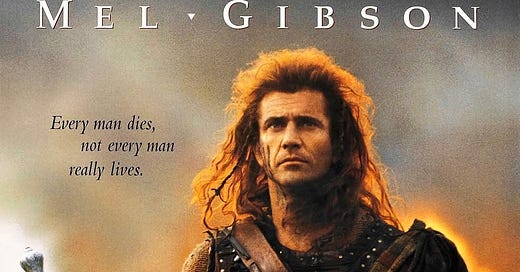In 1995 the movie Braveheart won several Oscars and my Medieval history students were ecstatic. Here was a little piece of 13th century Scottish/English history delivered to them in ways they could see over and over again: The Battles of Sterling, and Falkirk on the big screen! For a teacher like me—who figures that an educator’s main task is to get kids to wonder, to question, to ask if what is being delivered to them is actually true—the movie was a perfect setup because from a historical perspective, there is so much wrong.
Let’s start with kilt-wearing warriors. Cute, and allows for that iconic scene of bared buttocks, but Scots didn’t wear kilts for another couple hundred years. The blue face paint? A drib of truth because, the Picts likely did paint their faces (hence their name) but that was 1000+ years before. How about Mel Gibson’s clean-shaven face and head full of wind-blown locks with a bit of a mullet on top? Pure 1990s Hollywood. And the love affair between William and Isabella ? Nope. Isabella lived in France and was maybe 10 when Wallace was executed. The battles did happen, but not in the cinematic Highlands and the notable fact about Wallace’s victory at Sterling, was his strategic use of a bridge to bottleneck the English. No bridge in the film; likely would have required cutting some blue-faced yelling scenes. Finally, Braveheart is a great name , but it’s the wrong guy’s nickname. The real “Braveheart” was not William Wallace, but the guy depicted as his frenemy, Robert the Bruce.
The verdict? Braveheart is a historical mishmash, but it may have contributed to a bit of a boom in Scottish nationalism. As one Scottish scholar wrote, "Braveheart is fiction, but it made many Scots feel something true — that the past had been neglected and their stories under-told." — Dr. Fiona Watson, University of Stirling





There is nothing whatever wrong with fiction! Like poetry, it's where our souls live. History sometimes gives a story a nice scaffolding hang on, but we read (or watch) not necessarily to learn, but to be moved. xoxo I guess I better read Outlander!
For a more historically accurate portrayal of Scottish history: My understanding is that Diana Gabaldon (the author of the Outlander series - set in 1700's Scotland (and other centuries), strove for historical accuracy and practically beat the TV series adaptation script writers/ directors over the head to make sure they did the same.
For example, in one scene in the TV adaptation, the King of France offers Claire, the protagonist, a royal treat: a cup of hot chocolate. The script originally called for the king to share a taste of chocolate in solid bar form, but Diana pointed out that the process for creating chocolate bars would not be invented till almost a hundred years later.